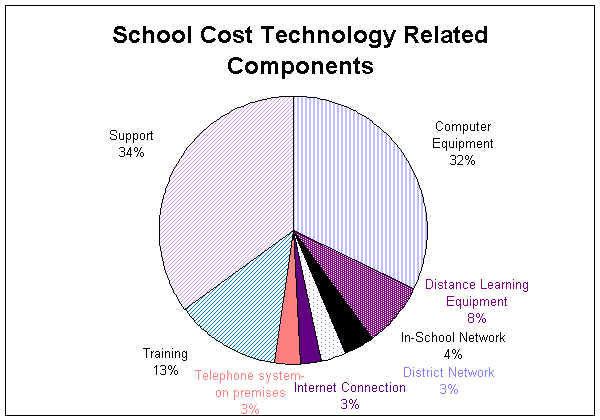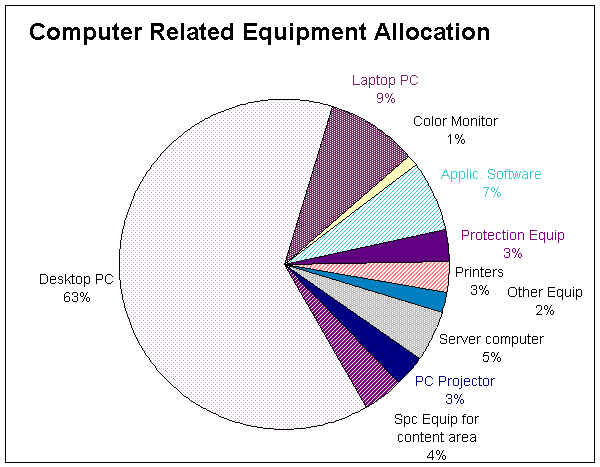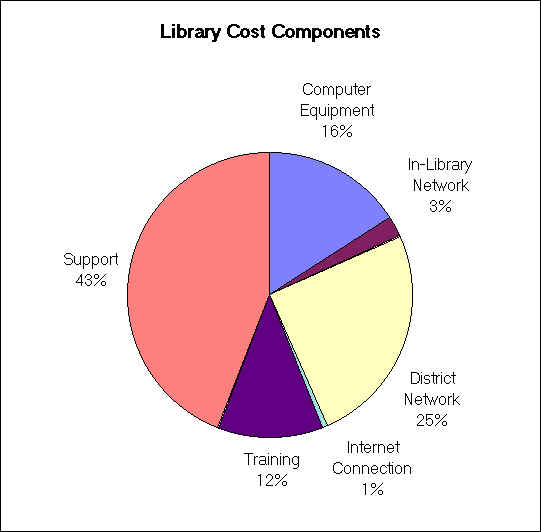
III. Educational Networking for New Jersey: The Costs
"If you think education is expensive - try ignorance."
-- Derek Bok
The projected costs discussed in this section do not include potential cost savings associated with leasing or savings associated with current equipment already in schools. This report calculates the overall cost of implementing this technology in a five-year model as discussed earlier, assuming that all equipment is purchased in the first year.4
The cost components in this section are divided into the following general categories:
Several important conclusions from this cost model emerge. First, support and teacher training represent roughly 51% of the total cost of implementing this educational technology in schools. In turn, approximately two-thirds of these costs are staff costs for maintaining equipment and facilitating educational uses of the technology. The training costs include tuition and transportation for attendance at formal training seminars.
Second, although this plan calls for highly functional computer networking (i.e., connecting all classrooms in schools and building high-speed district-wide networks), the overall cost of these computer network components is small compared with the costs of the computer equipment itself, and represents less than ten percent of the overal cost for the plan.
Third, the cost of computers represents about 32% of the total cost of this plan.
Finally, the specialized distance learning systems that are included in this plan represent a substantial cost to schools that can be justified by the enhanced quality and equity in education that these systems bring. To the extent that the availability of newer technology can allow ordinary computer and network systems to do what these systems do, New Jersey may find in the future that specialized distance learning costs could be reduced.
A. Public School Costs
Providing these systems to the 2,302 public schools in New Jersey would require an expenditure of $2.476 billion over five years, or $495 million per year. The average cost per student to implement this plan is $417 per year, of which $232/student/year is required in the form of new funding.
The table below shows the five-year cost of the plan for a typical New Jersey school:
| Component: | Per-School Cost (five years): |
| Computer Equipment | $346,125 |
| Distance Learning Equipment | 83,850 |
| In-School Network | 39,220 |
| District Network | 32,132 |
| Internet Connection | 27,810 |
| Telephone system-on premises | 31,200 |
| Training | 137,500 |
| Support | 377,814 |
| Total: | $1,075,652 |
The chart included on the next page provides a graphic view of the cost of school components, assuming that a school was beginning the process without any technology in place.
In fact, most schools will need to spend considerably less to develop a technology-rich environment, in light of data set forth in the 1996 New Jersey State Tech Survey Report. That survey, developed by the New Jersey Department of Education and QED (Quality Education Data), provides a snapshot of technology now in our schools. As stated earlier, that data show that there is on average one Internet-compatible computer in place for every nine New Jersey public school students. The ways in which data from this survey potentially reduce the total cost of technology for New Jersey public and not-for-profit schools is set forth in Appendix C of this report.


B. Library Costs
Providing computer and Internet access in 400 libraries in New Jersey, in conjunction with the school systems proposed, would require an overall expenditure of $51.8 million over five years, of $10.3 million per year. The cost of this plan per person served is $1.32 per year.
Compared with the systems for schools, the systems proposed for libraries represent a very small cost, less than two percent of the costs of school systems. Because several important costs (such as those of Internet access, support, and training) can be shared by schools and libraries, implementing these library systems would economically provide substantial benefits to the entire community.
As with schools, support and training for library systems represent a major portion of the total costs.
The district network in this plan accounts for a much larger portion of the total cost because the same type of networking link that is used for a school (which has a much larger overall cost) would be provided to a library. Such a link is valuable for library systems, however, since even a small number of computers can take advantage of the high performance of the district network and the access it provides to the Internet.
With an average of six computers per library, the typical library cost breakdown is shown in the table below:
| Component: | Per-Library Cost (five years): |
| Computer System | $20,550 |
| In-Library Network | 3,360 |
| District Network | 32,132 |
| Internet Connection | 921 |
| Training | 15,413 |
| Support | 57,220 |
| Total: | $129,596 |
The chart provided on the next page provides a graphic view of the cost of library components.

![]() Previous | Table of Contents | Next
Previous | Table of Contents | Next ![]()
Footnote
4 See Appendix C for a spreadsheet describing these costs in detail. School systems and libraries
may prefer to implement these systems over a number of years. The needs to upgrade physical
facilities, provide teacher training, and integrate the technology into curricula may prevent schools
and libraries from purchasing all systems initially as this plan proposes. Back